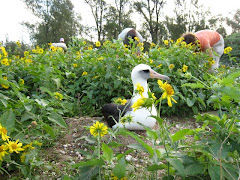

Post for Saturday June 19, 2010
Our Ocean, Our Choice
By: Sarah Wilson
Every day on Midway we open our day with a special oli (Hawaiian chant) to prepare our group for learning and openness. One morning this week Nai'a mentioned how amazing it is we are here together by choice. We chose to apply for PA'A last winter, they chose to accept us out of their copious stacks of impressive people, and we all chose to fly to this remote island archipelago in the middle (and I mean MIDDLE) of the Pacific Ocean. So here we are on our last day together on Midway and we continue to reflect on our choices....our choice in how to carry this unique experience with us in our daily life and how we will educate others. Our sessions help provide us with the content knowledge we need, while our "free" time is our personal exploration and adventures around the island that definitely fosters knowledge and inspiration. One of our sessions was exploring change in our oceans health. Robin Kundis Craig is a fellow PA'A member, environmental lawyer and professor at Florida State University College of Law in Tallahassee. She spoke to us about climate change, Marine Protected Areas (MPA's), and how the law and governance is involved in the conservation of species and ecosystems. The ocean is facing a variety of stressors from overfishing to marine debris and these combined impacts can take their toll. Add to the mix a steady change over time in climate and the combined resource use stressors and this can cause serious damage to ocean ecosystems.
Environmental law does not regulate the environment, it regulates humans. The law has to be tied to direct and indirect effects of what humans do to the environment. It is easier to prohibit a particular behavior in advance, such as oil extraction in a certain area, than it is to mandate later on in the form of habitat restoration after an oil spill. When measuring ocean use, money value is placed on ecosystem services, or the resources that ecosystems provide. Across the globe $33 trillion is provided from ecosystems and 2/3 of that value is from ocean ecosystems. With this numerical value now placed on the value of a healthy ocean….it would make sense that we want and need a healthy and productive ocean. What are the management steps Robin recommends to have this?
1.Pollution prevention….all types of pollution such as large plastics, derelict fishing gear and large scale chemical discharge and every day runoff from land.
2.Fishing regulations that are more conservative than those found now.
3.Create global Marine Protected Areas (MPA’s) which are similar to underwater national parks.
4.She advises most important is to admit that the old ideas of what is sustainability don’t work anymore and it is time for new ideas and new choices.
These regulations can contribute to a productive ocean…..but what about climate change? One major threat is the increase of carbon dioxide (CO2) in the atmosphere, and the ocean absorbs this CO2. This increase in CO2 in the ocean rises carbonic acid, making the oceans more acidic. Just like too much acid in the human body can cause issues it does in the ocean as well. From ocean animals forming week shells to coral skeletons growing at an extremely low rate ocean acidification has far reaching impacts.
So what are the top 2 things to practice to help reduce the combined harmful impacts the ocean is facing?
1.Use less…less plastic, less power, less driving.
2.Recycle plastics and papers and reuse items whenever possible.
Every day is a series of choices. What will yours be to help protect and restore the ocean?
Mahalo for joining us,
Sarah
Links to learn more:
Avoiding Jellyfish Seas, or, What Do We Mean by ‘Sustainable Oceans,’ Anyway? Article by PA’A member Robin Kundis Craig Professor with the Florida State University College of Law. Visit the Social Science Research Network to read abstract and download complete article.
http://papers.ssrn.com/sol3/papers.cfm?abstract_id=1658109
The Ocean Takes Care of Us, Let’s Return the Favor …The ocean is a vital resource that provides food, water, commerce, recreation, medicine and even the air we breathe. Today, our ocean faces unprecedented threats from pollution, trash, declining fisheries and multiple impacts from climate change.
http://www.thankyouocean.org/
National Geographic Ocean Portal
Visit our new ocean site to dive into all things blue! Explore the sea through our rich media collection, learn about ocean issues, news and how you can get involved in conservation efforts.
http://ocean.nationalgeographic.com/ocean/

























